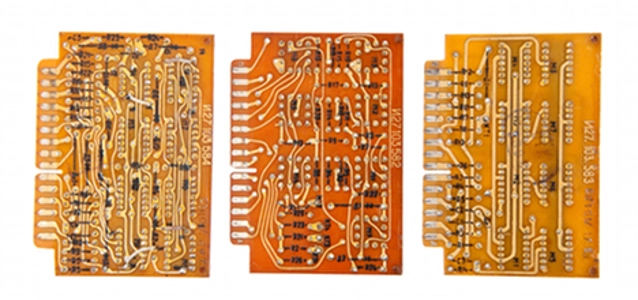
© alexan24-dreamstime.com
PCB |
Use it or lose it! Let the buyer beware
One was tempted to resort to Latin maxims to title this observation on the UK market for PCB laminates: Uti aut amittamus! Caveat emptor, but decided that plain English would convey a serious message more emphatically.
We are not talking about a shortage of supply. Quite the contrary; there are probably too many suppliers, resulting in a potentially unstable situation. This can be perceived by an outside observer as a market which certain customers are in danger of spoiling, not just for themselves, but for the industry as a whole.
A study of the business models pursued by many a printed circuit board shop reveals a great similarity. Companies are understandably proud of their technical competence and maturity, their strong relationships with their customers, their understanding of their strategic place in the supply chain, their achievements, in meeting industry standards and gaining OEM approvals, and their willingness to go that extra mile in servicing their customers’ demands.
And in the UK printed circuit industry, the emphasis is very much on service.
Those unfamiliar with the complexity of PCB manufacture can only marvel at the levels of competence and experience possessed by those technically-orientated souls who daily grapple with the intricacies and the culture of converting a sheet of copper-clad laminate to a complex PCB which meets all the customer’s specifications and expectations, produced with a minimum of wastage, and in the minimal amount of time. To achieve such a paragon of excellence, there is a critically important need to balance the processing competences of the board shop with the availability of the right materials, meeting the required specifications and approvals, in the right quantities, and in the right place at the right time. And this need is met by the laminate manufacturer with a properly developed service infrastructure. But this fundamental need is being challenged by an unwitting drift towards the more commercial aspects of the supply chain whilst losing sight of the reasons why such links need to be strong, and why they are. The human element creeps into the equation: materials buyers succumb to loss-leader offers from stockists and agents attempting to introduce their latest brand into the market, and the results are inevitably negative and potentially non-reversible. The temptation for the materials buyer to play one supplier off against another is understandable. Professional commercial negotiation is reasonable and acceptable, but the provocation of a price war benefits no-one: inevitably the OEM laminate supplier has the strength and resources to drive the merchant out of the market and then take the opportunity in the longer term to recover his costs – at the customer’s expense. Alternatively, in a limited market as exists in the UK, the OEM laminate supplier may decide to concentrate his efforts on supporting more substantial markets elsewhere. In either event, the local PCB manufacturing industry as a whole is the loser.© Jim Hughes dreamstime.com
From the aspect of technical service and support, one could consider the difference between a specialist shop and a supermarket. Within the shop is, historically, an esoteric level of knowledge and service that rivals the deserted aisles with their soulless displays of merchandise; within a shop one can be advised on how best to employ a product, and on other complementary items that may enhance this employment. And the specialist will generally have a not only full range of his particular product lines in stock, but will even have some which are called for only occasionally (such as unbalanced copper, heavy copper, extra thick laminate for example) . Within a supermarket, assuming you can (a) find anyone and (b) anyone with any degree of technical knowledge, the chances are that you come away with something that, whilst seemingly lower in price, turns out to be more costly in application. After 2003, and the rapid collapse of the PCB industry in the United Kingdom, there were many major suppliers who decided that it was no longer commercially viable to be regional, and tended to become more continental. Worries about the supply chain were considerable and the lack of choice as suppliers closed down or were bought up added to the concerns. Vacuums, however, tend to be filled, and usually by people who know the market, know the industry, and from previous experience know what it wants. They can bring stability to a supply chain, and support the major players, as well as the minor ones, by offering a level of technical service whilst supplying base materials at commercially realistic prices. Such companies tend to run ‘lean’, offering strong technical support and laboratory support, and combine knowledge of both product, and the production chain that it is to enter. Whilst the customer has his own expectations – yield, functionality, quality and price, he is not perhaps always aware of the limitations on the supplier that make it all possible. Thus it is that pursuing the lowest price may, in the short term; prove to be the undoing of that vital element – the 90% plus availability on a same-day basis of the whole range of laminates and prepregs, standard or oddball, direct from the primary manufacturer, some of whom can also assist their laminate customers with the supply of ancillary materials such as copper foils, backing and entry boards and release films. Once prices go through the floor-boards all that will be revealed is an empty basement, and the consequences for our domestic circuit board industry could be severe. Dealing directly with the laminator, and not with a coterie of would-be agents and distributors, who bring nothing to the table, avoids the terminator of instability. Reverting to the Latin: Uti aut amittamus! Caveat emptor! Use it or lose it! Let the buyer beware. Written By: Matthew Whyte© Yuryz dreamstime.com
